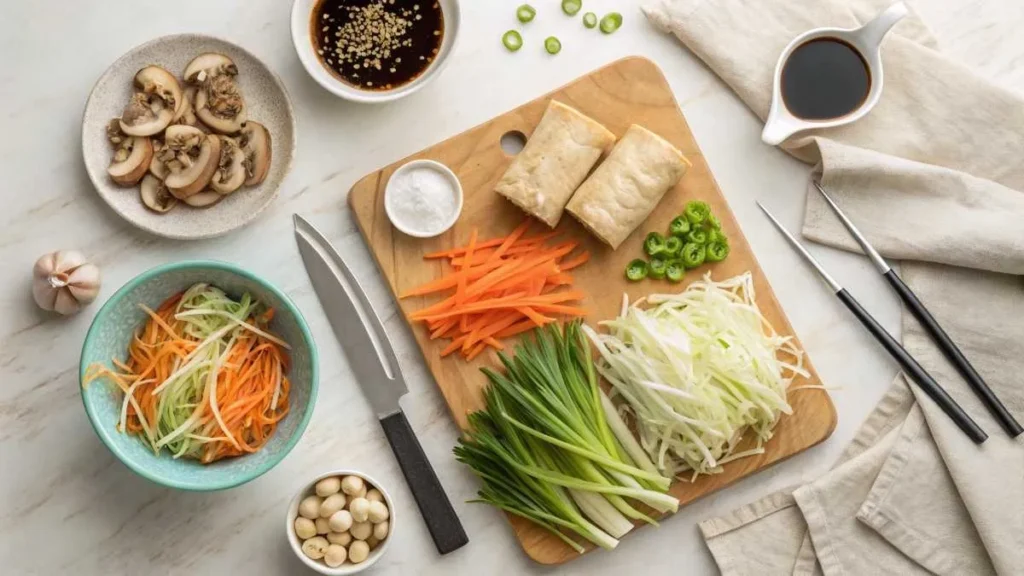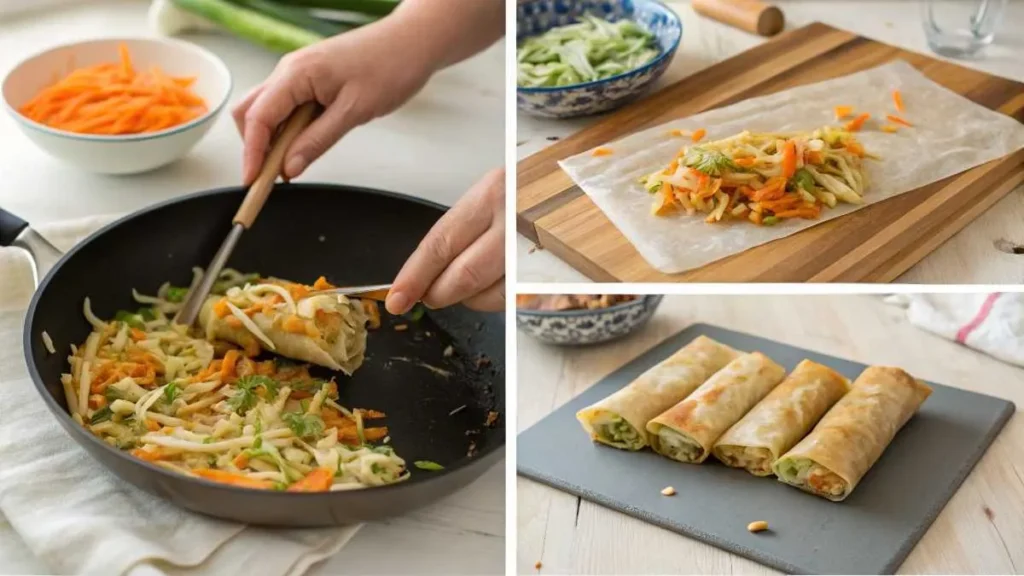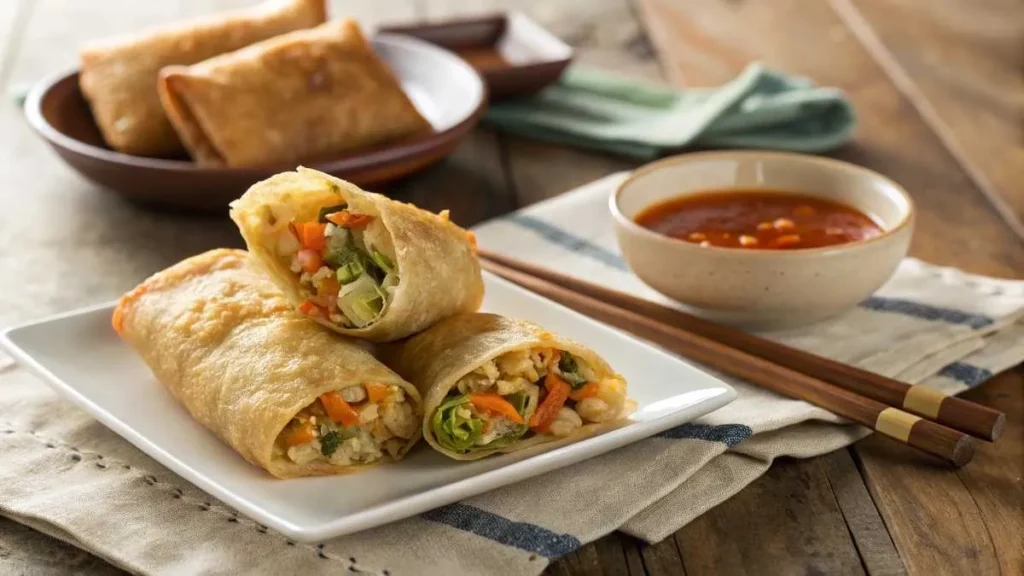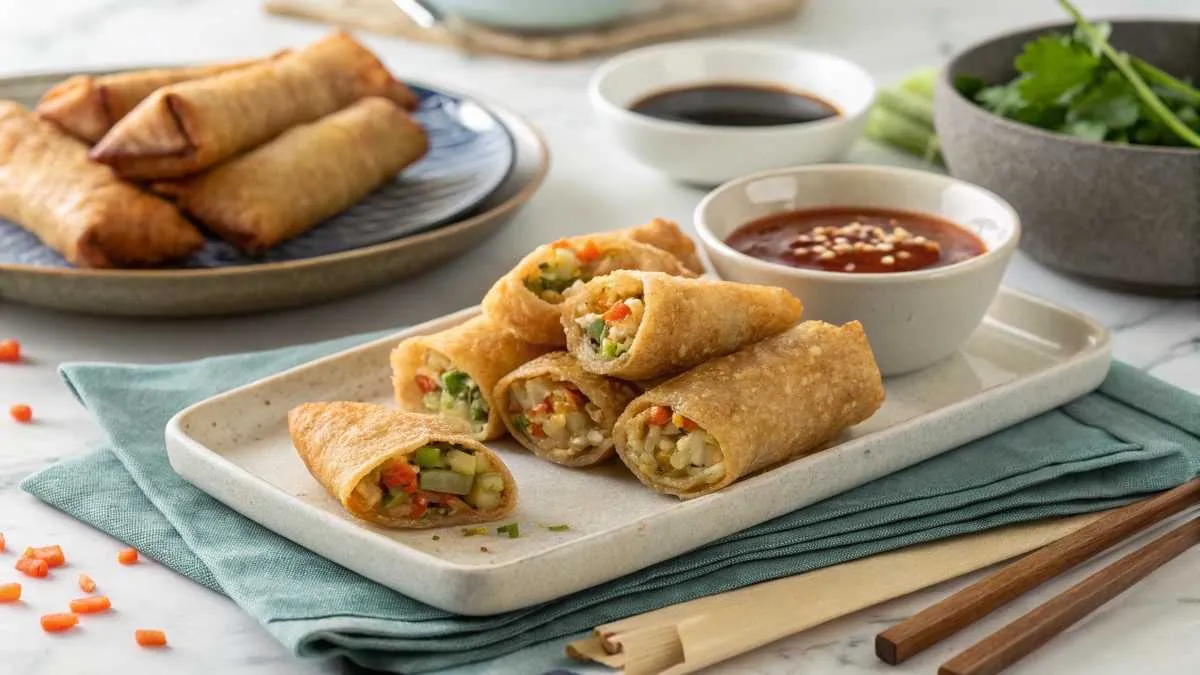Let’s be honest—there’s something downright magical about biting into a crispy, golden-brown egg roll. That first crunch, the burst of savory flavors, and the perfect balance of texture? Absolute perfection. And if you’ve only ever had them from a takeout box, you’re seriously missing out. Homemade veggie egg rolls? Game-changer. They’re fresher, crispier, and loaded with all the good stuff—no mystery ingredients here.
So, if you’ve ever wondered how to make veggie egg rolls at home that taste just as good (if not better) than your favorite restaurant’s, you’re in the right place. In this guide, I’ll walk you through everything—from choosing the best veggies to nailing that perfect wrap and crunch. By the end of this, you’ll be whipping up egg rolls like a pro.
Table of contents
History and Origins
Egg rolls have been around for ages, but their history isn’t as straightforward as you’d think. Unlike their cousin, the spring roll (which hails from China), egg rolls are more of an American-Chinese invention. While no one knows exactly who created them, many believe they started appearing in Chinese restaurants in the U.S. during the early 20th century. Unlike traditional spring rolls, which use thin rice paper, egg rolls are wrapped in a thicker, wheat-based wrapper that gets ultra-crispy when fried.
Veggie egg rolls, in particular, have become a go-to for vegetarians and anyone who just loves a lighter, fresher version of this classic snack. Instead of meat, they’re packed with a colorful mix of cabbage, carrots, mushrooms, and other veggies, all seasoned to perfection.
Nutritional Benefits of Vegetable-Filled Egg Rolls
Alright, let’s talk nutrition. While egg rolls have a bit of a reputation for being a greasy indulgence, veggie-filled ones can actually be pretty nutritious—especially if you bake or air-fry them instead of deep-frying.
Here’s why they’re a solid choice:
- Packed with Fiber – Thanks to cabbage, carrots, and other veggies, these little rolls help with digestion and keep you full longer.
- Loaded with Vitamins – Carrots bring beta-carotene (great for your eyes), while mushrooms add a dose of vitamin D.
- Lower in Calories (if baked or air-fried) – Traditional egg rolls can be heavy, but if you cut back on oil, they can be a much lighter treat.
And let’s be real—when you make them at home, you control what goes in. No weird preservatives, just fresh, wholesome goodness.
Essential Ingredients for Perfect Veggie Egg Rolls
Choosing the Right Vegetables
The best veggie egg rolls have a mix of crunchy and tender textures, and that all comes down to the filling. You’ll want a good balance of fresh, vibrant veggies that cook well together.

Here’s what I recommend:
- Cabbage (Napa or Green) – The backbone of any great egg roll. It’s crisp, slightly sweet, and holds up well when cooked.
- Carrots – Adds a natural sweetness and bright color. Plus, julienned carrots look super pretty in the filling.
- Mushrooms – Shiitake or cremini mushrooms bring that deep umami flavor. If you’re not a mushroom fan, you can skip them, but they really take the flavor up a notch.
- Bell Peppers – Red or yellow bell peppers add a subtle sweetness and a pop of color.
- Bean Sprouts – If you like a little extra crunch, toss in some bean sprouts. They’re light and refreshing.
- Green Onions or Chives – These give the filling a mild oniony kick without overpowering everything.
Pro Tip: Chop everything super thin! The thinner the veggies, the better they cook and the easier they are to roll up.
Egg Roll Wrappers: Store-bought vs. Homemade
Now, let’s talk wrappers. You’ve got two options:
- Store-bought wrappers – The easiest route. You’ll find these in the refrigerated section of most grocery stores, usually near tofu or dumpling wrappers.
- Homemade wrappers – If you want to go all out, you can make your own using a simple flour-and-water dough. But honestly, the store-bought ones work just fine, and they save a ton of time.
Whatever you choose, make sure they’re fresh! Dry, old wrappers crack when you roll them, and that’s a nightmare you don’t want.
Seasoning and Sauce Options
A great veggie egg roll is all about flavor, and that comes from the seasoning. While the veggies themselves bring a lot to the table, a little extra seasoning makes them shine.
Here’s a simple go-to mix:
- Garlic & Ginger – Fresh is best. Minced garlic and grated ginger add depth and warmth.
- Soy Sauce – Brings saltiness and umami. Low-sodium soy sauce works too.
- Sesame Oil – Just a little for a nutty aroma (don’t go overboard—it’s strong!).
- Rice Vinegar – Adds a tiny bit of tang to balance the flavors.
- White Pepper – Milder than black pepper and perfect for Asian-inspired dishes.
For sauces, you’ve got plenty of options:
- Classic sweet and sour sauce – Tangy, sweet, and perfect for dipping.
- Spicy peanut sauce – A creamy, nutty twist with a little heat.
- Hoisin or plum sauce – If you like a deep, slightly sweet flavor.
“A good dipping sauce takes an egg roll from great to unforgettable.”
Step-by-Step Guide to Making Veggie Egg Rolls

Preparing the Vegetable Filling
Alright, time to get cooking! The filling is the heart of your egg roll, and making it right is key.
- Shred the cabbage and carrots – Use a sharp knife or a mandoline slicer. You want thin, even pieces.
- Chop the mushrooms and bell peppers – Keep them small so they blend well with the other veggies.
- Sauté the aromatics – Heat a pan, add a little oil, then toss in garlic and ginger. Let them sizzle for about 30 seconds.
- Add the veggies – Start with mushrooms and bell peppers (since they take longer to cook), then toss in the cabbage and carrots.
- Season to taste – Drizzle in soy sauce, a dash of sesame oil, and a sprinkle of white pepper. Stir-fry for about 3-4 minutes until everything is just tender but not mushy.
- Let it cool – Before wrapping, spread the filling out on a plate to cool down. Hot filling = soggy egg rolls.
“The key to a perfect filling? Cooking it just enough to soften the veggies while keeping that satisfying crunch.”
Mastering the Wrapping Technique
Now that the filling is ready, it’s time for the fun part—wrapping! This step can feel a little tricky at first, but once you get the hang of it, it’s actually pretty simple.
Step-by-Step Wrapping Guide for Veggie Egg Rolls
- Lay Out the Wrapper – Place an egg roll wrapper on a clean surface in a diamond shape (one corner pointing toward you). If the wrapper feels a little dry, cover the rest with a damp towel to keep them from cracking.
- Add the Filling – Spoon about 2 tablespoons of the veggie mixture onto the lower third of the wrapper. Don’t overfill, or they’ll be impossible to roll properly.
- Start Rolling – Fold the bottom corner up and over the filling, rolling it tightly. You want to keep it snug, but don’t squeeze too hard, or the wrapper might tear.
- Fold in the Sides – Next, fold in both side corners toward the center, almost like making an envelope.
- Seal the Roll – Finally, roll the egg roll up all the way to the top corner. Before sealing, dab a little water (or a cornstarch slurry) along the edge to help it stick. Press gently to secure.
“The tighter the roll, the crispier the egg roll! Loose wrappers trap too much air and can burst open while cooking.”
Cooking Methods: Frying vs. Baking
Now that your egg rolls are wrapped and ready to go, let’s talk about the best way to cook them. There are a few different methods, and each has its own pros and cons.
Frying (The Crispiest Option)
Frying is hands-down the best way to get that golden, shatteringly crisp shell. If you’re all about texture, this is the way to go.
How to Fry Egg Rolls:
- Heat the Oil – Pour about 2 inches of vegetable oil into a deep pan. Heat it to 350°F (175°C)—any hotter, and they’ll burn; too cool, and they’ll turn greasy.
- Test the Oil – Drop a small piece of wrapper in. If it sizzles immediately, you’re good to go.
- Fry in Batches – Carefully place a few egg rolls in the hot oil, making sure not to crowd the pan. Fry for 3-4 minutes, turning occasionally, until they’re golden brown and crispy.
- Drain Excess Oil – Remove them with a slotted spoon and place them on a plate lined with paper towels to soak up any extra oil.
Baking (A Healthier Alternative)
If you want a lighter option, baking is a great choice. While they won’t be quite as crispy as the fried version, they still get nicely golden and crunchy.
How to Bake Egg Rolls:
- Preheat the Oven – Set it to 400°F (200°C).
- Brush with Oil – Lightly brush or spray each egg roll with vegetable oil. This helps them crisp up instead of turning dry.
- Bake for 20-25 Minutes – Place them on a baking sheet lined with parchment paper and bake, flipping halfway through.
Air Frying (Best of Both Worlds)
Want the crispiness of frying without all the oil? An air fryer is the perfect middle ground.
How to Air Fry Egg Rolls:
- Preheat to 375°F (190°C).
- Lightly Spray with Oil – A quick mist of cooking spray helps them crisp up.
- Cook for 10-12 Minutes – Flip them halfway through for even browning.
“No matter how you cook them, always let your egg rolls rest for a few minutes before eating. The filling stays piping hot!”
Variations on Classic Veggie Egg Rolls
Once you’ve nailed the basic recipe, why not mix things up? There are so many fun ways to change up the flavors.
Asian-Inspired Flavor Combinations
If you want something with extra depth, try adding:
- Kimchi – A spicy, tangy twist from Korea.
- Thai Basil & Lemongrass – Bright and aromatic.
- Curry Powder – A mild heat with warm, earthy flavors.
Fusion Veggie Egg Rolls Ideas
Feeling creative? Try these fun twists:
- Mexican-Inspired Egg Rolls – Add black beans, corn, and a little cumin. Serve with avocado sauce.
- Greek-Style Rolls – Spinach, feta, and a touch of oregano for a Mediterranean vibe.
- Buffalo Egg Rolls – Toss the filling with a little hot sauce and serve with ranch dressing.
Vegan and Gluten-Free Adaptations
For a vegan version, skip the egg in the wrapper (most store-bought ones are already vegan). If you need a gluten-free option, look for rice paper wrappers instead!

Dipping Sauces and Pairings
A good dipping sauce makes all the difference. Here are a few must-try options:
Classic Sweet and Sour Sauce
A tangy, slightly sweet sauce that pairs perfectly with crispy egg rolls.
Ingredients:
- ½ cup rice vinegar
- ¼ cup ketchup
- 3 tbsp brown sugar
- 1 tbsp soy sauce
- 1 tbsp cornstarch mixed with 2 tbsp water
Instructions:
- Combine everything (except cornstarch mix) in a saucepan.
- Bring to a simmer, then stir in the cornstarch slurry.
- Cook for 1-2 minutes until thickened.
Spicy Peanut Sauce Recipe
If you love bold flavors, this creamy peanut sauce is a winner.
Ingredients:
- ¼ cup peanut butter
- 2 tbsp soy sauce
- 1 tbsp lime juice
- 1 tbsp sriracha
- 1 tbsp honey
Instructions:
- Whisk everything together in a bowl until smooth.
- Adjust seasoning as needed.
“A great sauce takes a good egg roll and makes it unforgettable.”
Frequently Asked Questions
Common choices include cabbage, carrots, mushrooms, bell peppers, and bean sprouts. You can mix and match based on your preference.
Yes, especially if baked or air-fried! They’re packed with fiber and vitamins, but frying adds extra calories.
PF Chang’s version includes cabbage, carrots, mushrooms, green onions, and garlic, all wrapped in a crispy shell.
Egg rolls have a thicker, crispy wrapper and can contain meat, while vegetable rolls are lighter and always plant-based.
Conclusion:
Making homemade veggie egg rolls isn’t just about cooking—it’s about creating the perfect balance of crispy, golden wrappers and flavorful, well-seasoned fillings. From choosing the right vegetables and mastering the wrapping technique to deciding between frying, baking, or air frying, every step plays a role in achieving that irresistible crunch. Plus, with endless flavor variations, dipping sauces, and make-ahead options, you can customize them to fit any diet, whether you need vegan, gluten-free, or keto-friendly egg rolls.
If you’re ready to take your egg rolls to the next level, now’s the time to try this easy recipe at home! Have a favorite dipping sauce or a fun twist on the classic veggie filling? Drop a comment below and share your best tips! And don’t forget—if you loved this guide, share it with fellow food lovers and bookmark it for later. Happy cooking!
